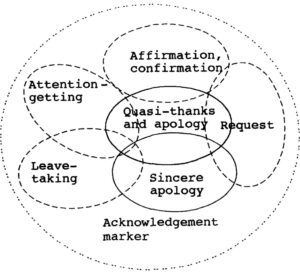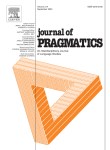論文の概要
本論文は、日本の公共空間において用いられる「すみません」ということばに着目している。方法論としては、まずエスノグラフィーによるミクロな観点から「すみません」ということばを記述・分析することで7つの機能に分類している。さらに、マクロな観点からも「すみません」ということばが持つ社会的・メタ語用論的なフレームワークがいかに構築されているかを分析している。
この論文は、実際に公共空間で使用されている「すみません」をエスノグラフィックにデータ収集し、日本の社会的な空間において行われる「あいさつ」といったよりメタ的で社会文化的なコンテクストを参照するフレームワークをも射程に入れた議論を展開している。
「あいさつ」の儀礼的に用いられる側面と、日本語として表象される中に埋め込まれている規範的意識をも照射する分析となっている。 以下、Ide(1998)によるアブストラクト。
Sumimasen, the object of analysis in this study, is a conventional expression of apology in Japanese that is also used to express the feeling of thanks. While many of the previous studies on the use of sumimasen attempted to explain the dual functions of the expression from a speech act point of view, this study aims to elucidate the social and metapragmatic functions of sumimasen within the larger framework of public discourse in Japan. The paper first describes seven pragmatic functions of sumimasen distinguished through ethnographic observations of discourse in public, using Goffman’s notion of ‘remedial’ and ‘supportive’ interchanges (1971) as a conceptual framework. Then, the paper demonstrates that the exchange of sumimasen forms a metapragmatic ritual activity that is an anticipated, habitual behavior in public discourse in Japanese society. This argument is developed by reframing the multiple functions of sumimasen in accordance with the folk notion of aisatsu, which constitutes the ground rules of appropriate Japanese public interaction. The paper ultimately discusses how sumimasen functions not only as the expression of gratitude and apology, but also as one of the ritualized formulae used in Japanese society to facilitate public face-to-face interaction.
論文の目次
- Introduction: Why be sorry when you are grateful?
- Overview of study
- Setting the context of analysis
- The multiple functions of sumimasen
- Sumimasen as sincere apology
- Sumimasen as quasi-thanks and apology
- Sumimasen as request marker
- Sumimasen as attention-getting device
- Sumimasen as leave-taking device
- Sumimasen as affirmative and confirmational response
- Sumimasen and its functions in public discourse
- Sumimasen as remedial and supportive interchanges
- ‘Alter-oriented’ and ‘role-bound’ discourse
- Sumimasen in light of proper public interaction in Japan
- Concluding remarks
論文ミニレビュー
Ide(1998)はオースティンやサールによって提起された発話行為論に対し、十分に説明しきれない、より広範囲の社会文化的コンテクストを必要とする語用論的な言語機能・使用の一例として「すみません」を題材に分析を行っている。論文には二つの目標があるという。
- to examine the functional and contextual meanings of sumimasen extracted from recordings of actual discourse(実際の談話として収集した「すみません」の機能的で文脈上の意味を調べること)
- to discuss the social meaning of sumimasen, emerging through its everyday pragmatic usage and refrecting the lager framework of interaction behavior in Japanese society(日法の言語使用の中で表象され、日本社会で行われる相互的な振る舞いというより大きなフレームワークを反映する「すみません」の社会的意味の側面を議論すること)
実際に使用されている「すみません」の収集は、東京の都市部に立地する眼科クリニックで総計9時間の収録を行って集められている。「日本社会」として議論を展開してはいるが、あくまでも実施した東京の中で代表されるものであり、また「あいさつ」はその他にも「ごめんなさい」や「ありがとう」などがあることも言及することで(その際に「社会化」についても言及)、少数の事例から極端な一般化をしているのではなく、むしろ「細部に宿る普遍性」を読み解く試みだと言える。
語用論分野で元来から問題となるのは、「どこまでをコンテクストとして含めるのか」、個別の分析を行う論文の問題系として捉えるのならば「どこまでをコンテクストとして処理できるだけの理論・方法論的な整理がされているか」が問われるといっていいだろう。この問題系は広く社会科学で議論されるような「存在論・認識論」レベルの問題をも含みうるもので、一概に断定しえるものではない。が、少数の事例といえど、エスノグラフィックにフィールドワークを実施して実際のデータを集め、如何に公共空間で「すみません」の持つ語用論的側面が浮き彫りだつかを実証的に読み解く術を示していると感じた。
下記の図はIde(1998: 522)から引用した、「すみません」が持つ7つの機能をまとめた図である。

By focusing the frame of study on public interaction, the paper has elucidated the metapragmatic rule that governs these seemingly different speech behaviors in Japanese social interactions.(公的な相互行為上におけるフレームワークの研究として焦点を当てることで、一見異なる日本社会の相互的な振る舞いに影響を与えるメタ語用的な規則をこの論文では説明してきた。)
このように、それぞれの機能は独立しているのではなく重層的に社会文化的な意味を構築しているのであり、言語の機能や使用の意味をことばのやり取りの中で読み解くにあたって、メタ語用論的な規則にも影響されていると言えるというわけだ。
「日本文化論」として過度に一般化された文化論としてではなく、研究者がフィールドに赴いて実際の言語使用を記述し、さらにそれを社会文化的なコンテクストとして理論・方法論として参照することで、日常で何気なく用いられていることばのやり取りの中にある文化的要素を分析することができる。もちろん、それらが大文字の「文化」として必ずしも象徴されているわけではないが、むしろ、これまで議論されてきた人々の行為を分析する文化的側面を、実証的に読み解き、また反省的に振り返ることが語用論的な分析で行うことができると考えられるだろう。

